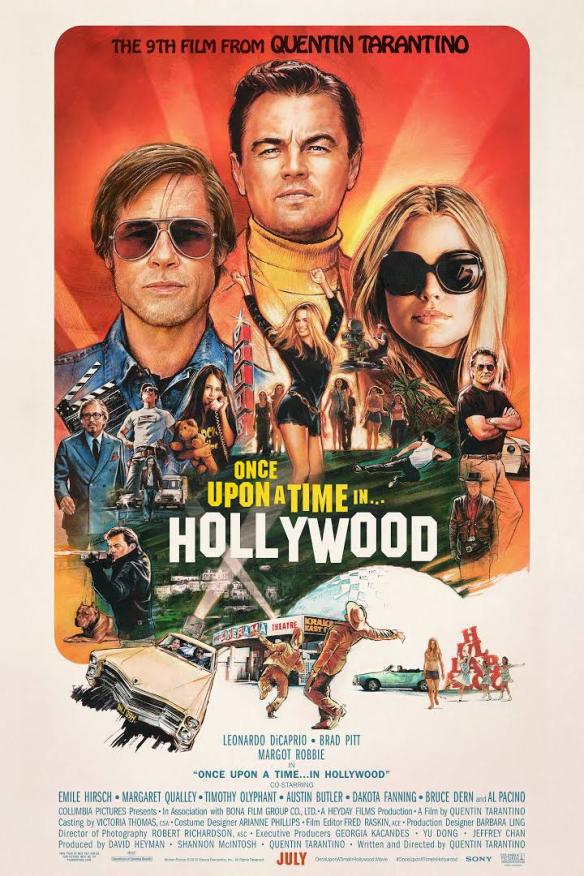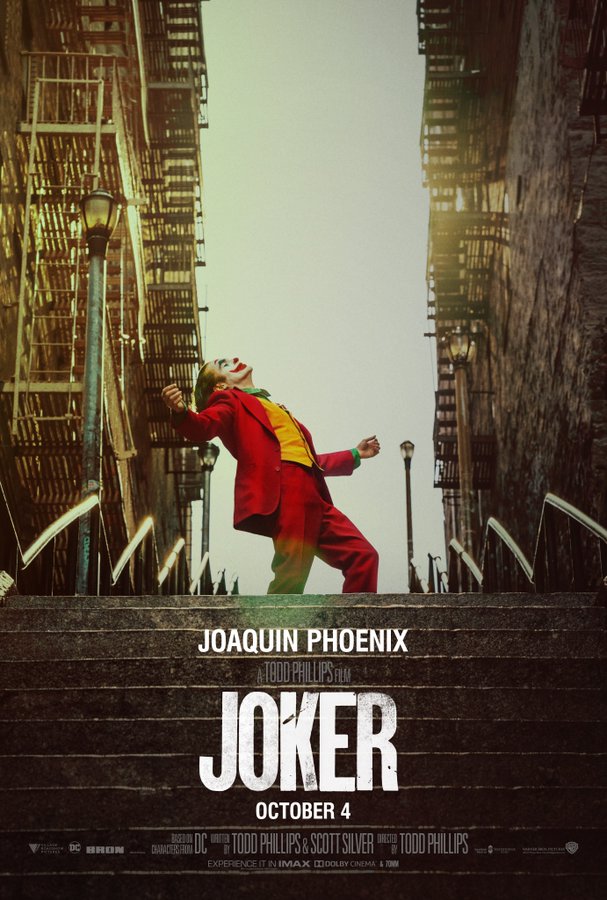Arthur Fleck is a sick man. Not just in the sense that he has a condition that causes him to laugh uncontrollably. He’s sick in that he is delusional. He routinely hallucinates that people on the TV are interacting with him. At the start of the film, we learn that he was previously institutionalized and that he’s on no less than seven different medications. He is a man barely holding on to sanity. So what will happen when the city program giving him his meds gets shut down, he gets fired from his job at a clown for hire company, and a group of Wall Street types attacks him, unaware that he has a gun? Watch the movie and find out. Continue reading
Tag Archives: Gun Violence
Once Upon A Time In Hollywood (2019)
Featured

It’s 1969, and Rick Dalton (Leonardo DiCaprio) is a fading, Western actor, struggling to maintain relevance in a rapidly changing Hollywood. His only friend is his driver, and longtime stunt man, Cliff Booth (Brad Pitt), a Vietnam vet whom it is heavily implied murdered his wife. The two spend their days driving around LA, getting drunk, watching Rick’s various TV appearances, and debating about whether or not the latter should take an offer to make Spaghetti Westerns in Europe. Meanwhile, Hollywood director Roman Polanski and his wife, Sharon Tate (Margot Robbie), have just moved into the house beside Dalton. Dalton sees in Polanski a chance to become legitimate again, and eagerly tries to get in their good graces. Something that could throw a wrench in his plans, however, is a small, delusional band of Hippies living out in a place called Spawn Ranch, who may or may not be hatching a murder scheme. Continue reading
Hold The Dark (2018)

In the remote town of Keelut, Alaska, children are being taken. Not by humans, but by wolves. Two Yupik youngsters have already gone missing. And now, it seems, a little White boy has as well. As such, his mother, Riley Keough, summons Jeffrey Wright, an expert on the animals, to come and find the pack that killed her son. When Wright gets there, however, he finds that all is not as it seems to be. For starters, Keough seems slightly crazy. (In one scene, she climbs into bed with him, and tries to get him to strangle her). And when Wright looks in the basement, he finds that wolves didn’t eat the boy. Keough, his own mother, killed him. This revelation, coupled with Keough’s disappearance, sends her husband, Alexander Skarsgård, an unhinged Iraq War vet, on a killing spree to find her, and leaves Wright, and local sheriff James Badge Dale, completely in the dark as to what the hell’s happening. Or maybe that’s just the audience. Continue reading
Sicario (2015)

The story of an FBI hostage retriever, Emily Blunt, getting called on board a joint DOD-CIA task force to bring down a drug cartel responsible for a horrific bombing, the film offers very little in the way of hope or redemption. Child murder, torture, opening fire in crowds filled with civilians, these are but a sampling of the horrific things that happen in this movie. Continue reading
What A Bloody Mess Part 2: Takashi Miike’s Ichi The Killer

There are some movies out there that are so vile, so depraved, so unspeakably awful, that they actually transcend the realm of bad taste and, in the eyes of certain critics, become worth watching. No, I’m not talking about Flowers Of Flesh And Blood or The Human Centipede: Full Sequence. I’m referring to films such as Lars Von Trier’s Antichrist, Ruggero Deodato’s Cannibal Holocaust, Stanley Kubrick’s A Clockwork Orange and, of course, Takashi Miike’s Ichi The Killer. These movies not only sickened audiences to the point of vomiting, walking out and, in the case of Ichi The Killer, unconsciousness, they also got people praising their directors’ “artistic vision” and critics raving about their “social, cultural and political relevance.” Why? Well, at one point in the not to distant past, I would have said, “I have no idea,” or else, “as a means of self-defense.” I used to think that critics and cinephiles made cult classics out of these movies because they just didn’t want to believe that someone would put the time, money, and dare I say, effort, into making something so profoundly twisted. Now, however, I’m not so sure I can stand by that previous assertion. Yes, these movies are disgusting in every sense of the word, but the fact remains, some of these films were actually made with a specific social and/or political agenda in mind. A Clockwork Orange, for example, is a story about freedom, the freedom to do and think as we please, and how society strives to limit that freedom by forcing us all to conform to a certain standard of behavior. As for the others, they might not necessarily have been made with a specific message in mind, but they are just vague, and over the top enough, to have the potential to be profound. Case and point; Ichi The Killer. Continue reading
Taxi Driver: When Doing The Right Thing Was Wrong.

I won’t lie, I’m feeling a little uneasy about uploading this latest analysis. Why, you might ask? Well, anytime you discuss something that’s dark or unpleasant, you tend to get negative back-lash, and if there are any two words in the English language that perfectly summarize Taxi Driver, the classic psychological thriller starring Robert De Niro, they are “dark” and “unpleasant.” The movie explores some of the most unflattering aspects of American society–racism, gun violence, drug abuse, child prostitution and pornography to name a few–in great detail. When it hit the theaters in 1976, it sickened audiences with its graphic depictions of violence, and then in 1981 became a lightning rod for controversy when John Hinckley Junior cited it as his inspiration for shooting President Reagan. But the truth is, I’m nervous about uploading this analysis for more reasons than simply the unpleasant nature of the film’s content. Anyone who knows me in real life knows that I’m not the sort to shy away from controversial subjects. What truly gives me pause about uploading this analysis is the fact that the film I’m discussing is so well known, and has been analyzed by so many people, that I’m afraid that if someone reads it, he or she will either say, “I’ve heard all this before,” or “No! This guy’s got it all wrong!” See, we like to say that there’s no such thing as an incorrect interpretation when it comes to works of art, but that’s not true. If, for example, one knows what the artist’s intentions were when he or she produced the piece, then one might be able to say that one knows the true meaning of the work. Similarly, works that have been around for a long time tend to acquire “correct interpretations” and “accepted meanings.” For example, The Great Gatsby is widely considered to be F Scott Fitzgerald’s literary condemnation of the selfish, hedonistic and ostentatious lifestyle practiced by the newly rich during the Jazz Age. If, however, someone were to assert that Gatsby was also a commentary on the racism, xenophobia and anti-semitism present in America during the ’20s–citing the character Tom’s reading of The Rise of the Colored Empires and the inclusion of a Jewish gambler, Wolfshime, as his or her proof–that individual would likely be met with laughter or incredulously arched eyebrows. Similarly, Taxi Driver has some widely accepted interpretations, particularly surrounding the protagonist, Travis, and it is these widely accepted readings that I will be challenging today. See, I’ve given it a great deal of thought, and I think I might finally have found out who this character is. I’ll probably get crucified by other film critics, but I don’t care. Taxi Driver is an incredibly important film to me, as it is to a lot of people, and I feel like if I didn’t share ALL my thoughts on it, I wouldn’t be able to call myself a true admirer. So, keeping all that in mind, let’s begin this dissection of the delightful, the despicable, and the dangerous, Taxi Driver. Continue reading

